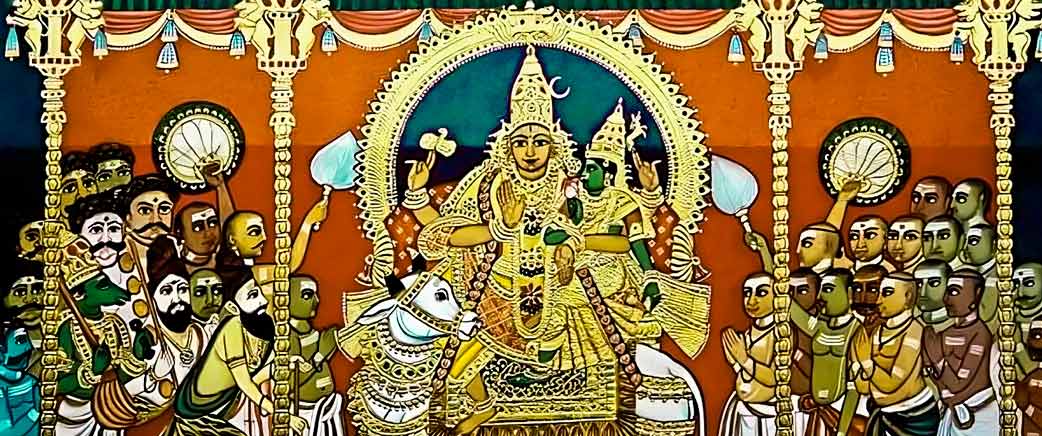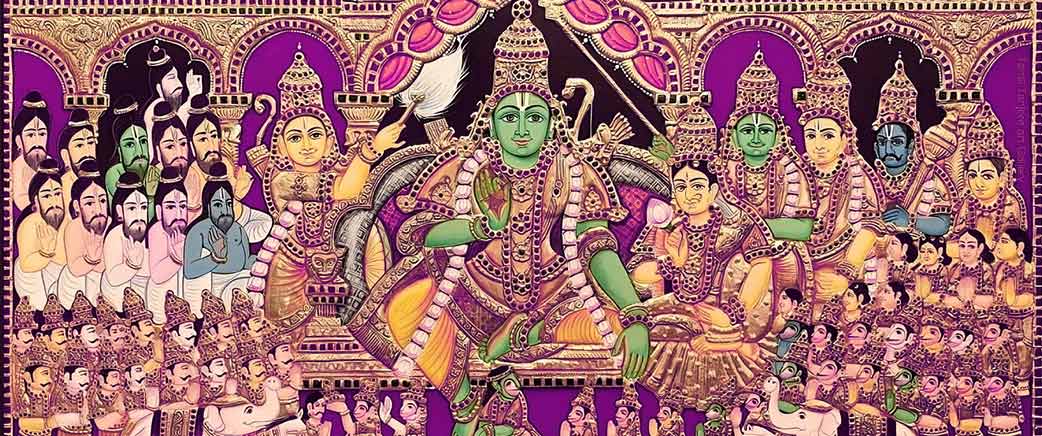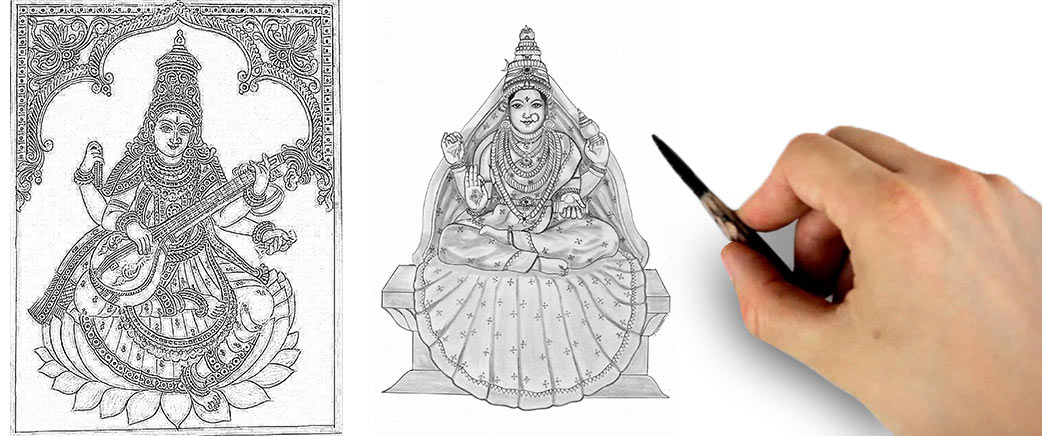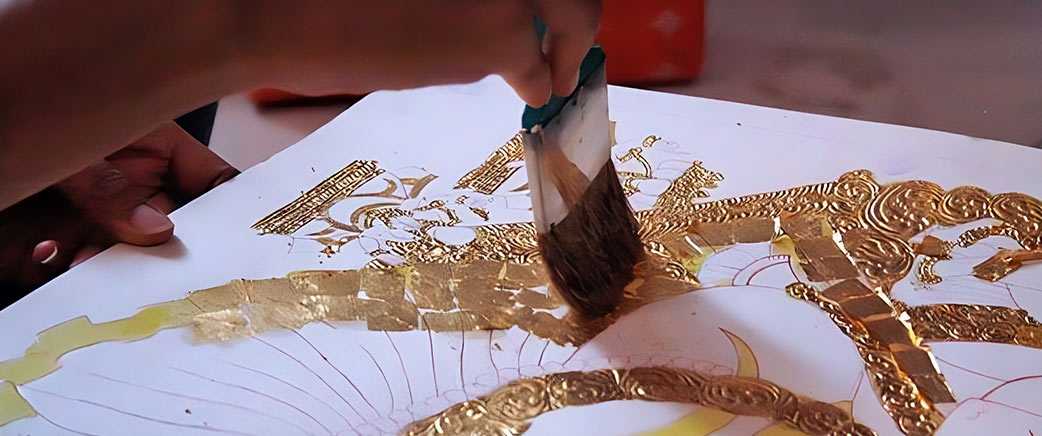
Mysore Painting is an expression of unwavering dedication and affection. These are also called Mysuru Paintings. Mysore paintings are a famous style of classical South Indian painting that originated in and around the city of Mysore in the Indian state of Karnataka in the 13th century. By their mere existence, Mysore Paintings can instantly convert any ordinary environment into a wealthy, royal one.
Mysore paintings were created during the reign of the Vijayanagar Empire. The monarchs of the Mysore region gave these paintings their blessing, and they maintained that backing even during the British era. The major theme of the Mysore paintings is a portrayal of the Hindu god or goddess. Each of these paintings has two or more figures, but only one of them takes center stage in terms of scale and color, making them stand out from other paintings.
Finely formed lines, precise brushstrokes, exquisite figure delineation, subtly integrated brilliant vegetable colors, and sparkling gold foils are features that set Mysore paintings apart. You can also see this Outstanding Mysore Painting of Lord Krishna’s Vishwaroopam and its details. The paintings are more than just aesthetic items; they aim to arouse feelings of adoration and humility in the viewer. As a result, the individual painter’s ability to convey various emotions is crucial for this type of painting.
The majority of Mysore’s paintings involve religious themes. Tanjore and Mysore paintings seem similar, which causes many people to confuse the two. The artist uses jewels in Tanjore paintings, but not in Mysore paintings, which is the major distinction between the two.
Mysore paintings were created during the reign of the Vijayanagar Empire. The monarchs of the Mysore region gave these paintings their blessing, and they maintained that backing even during the British era. The major theme of the Mysore paintings is a portrayal of the Hindu god or goddess. Each of these paintings has two or more figures, but only one of them takes center stage in terms of scale and color, making them stand out from other paintings.
Finely formed lines, precise brushstrokes, exquisite figure delineation, subtly integrated brilliant vegetable colors, and sparkling gold foils are features that set Mysore paintings apart. You can also see this Outstanding Mysore Painting of Lord Krishna’s Vishwaroopam and its details. The paintings are more than just aesthetic items; they aim to arouse feelings of adoration and humility in the viewer. As a result, the individual painter’s ability to convey various emotions is crucial for this type of painting.
The majority of Mysore’s paintings involve religious themes. Tanjore and Mysore paintings seem similar, which causes many people to confuse the two. The artist uses jewels in Tanjore paintings, but not in Mysore paintings, which is the major distinction between the two.

Art Technique Of Mysore Paintings: Gesso Work

Mysore paintings are created in Karnataka, India using the traditional technique known as Gesso Work. The first stage in creating a painting is setting up the background or canvas. Mysore paintings can be created on various surfaces, including paper, wood, walls, and fabric. Mysore paintings were once painted on the stones and walls by artists. Gum, chalk, and yellow ochre prep the walls before painting.
However, Mysore paintings are typically created on a piece of paper or a piece of wood. Paper pulp or waste paper is used to make the board. A polished Quartz pebble is used to massage the board’s surface smooth after it has dried in the sun.
If the canvas is a cloth, then the cloth was pasted on a wooden plank using a paste. The paste is composed of dry white lead (safeda) mixed with gum and a small quantity of gruel (Ganji). After that, the wooden plank is air-dried and burnished. Dry white lead, yellow ochre, and gum are used to prepare wood surfaces.
However, Mysore paintings are typically created on a piece of paper or a piece of wood. Paper pulp or waste paper is used to make the board. A polished Quartz pebble is used to massage the board’s surface smooth after it has dried in the sun.
If the canvas is a cloth, then the cloth was pasted on a wooden plank using a paste. The paste is composed of dry white lead (safeda) mixed with gum and a small quantity of gruel (Ganji). After that, the wooden plank is air-dried and burnished. Dry white lead, yellow ochre, and gum are used to prepare wood surfaces.
Sketching

Following the preparation of the canvas, the artists use a crayon to make a rough sketch of the painting. The crayon used in the drawing is made from a tamarind tree’s straight twig. Then, the most key features, such as the deity’s facial features, the jewelry they wore, and their clothing, are depicted in full detail.
Coloring and Gesso
Following the coloring of the figures, the artists would go into more depth about their facial features, attire, and ornamentation. One of the most essential elements of Mysore’s painting was the gesso work. Gesso is a mixture of Arabic gum and chalk powder. They were properly combined to form a liquid paste that was smooth.
The artist then applies the paste with a brush on the artwork to create an embossing effect. Some artists also use a cone to do this procedure. They fill the mixture in a cone and then draw the embossed area. It gives the painting a 3D effect.
The artist then applies the paste with a brush on the artwork to create an embossing effect. Some artists also use a cone to do this procedure. They fill the mixture in a cone and then draw the embossed area. It gives the painting a 3D effect.
The painting’s embossed sections are extremely meticulously covered with gold foil. 24-carat gold foil is used to cover the painting. The gold foil is cut into the proper shape by the artist, who then uses gentle hands to apply it to the picture. The gold foil gives the final touch to the painting. The addition of gold foil gives the paintings an air of royalty and opulence.

Let's Explore More About Gesso-Work
In Karnataka, using Gesso Work is still a common painting technique. White lead powder, gum arabic, and glue are the ingredients of gesso. The white lead powder is made up of primary lead carbonate, which occurs naturally as a mineral and aids in the darkening of the painting in Gamboge color, the slightly transparent, rich saffron mustard pigment. Gesso is wrapped in gold foil and used as an engraving medium.
Mysore paintings have intricate, low-relief gesso work. Mysore paintings used gesso on the pillars and arches that generally framed the deities to exhibit intricate designs of clothes, jewels, and architectural aspects. To securely hold the gold foil, the process was begun in the morning when the painting’s base was still wet.
Mysore paintings have intricate, low-relief gesso work. Mysore paintings used gesso on the pillars and arches that generally framed the deities to exhibit intricate designs of clothes, jewels, and architectural aspects. To securely hold the gold foil, the process was begun in the morning when the painting’s base was still wet.
After letting the painting dry, the glazing procedure was completed by covering it with thin paper and rubbing it with the soft glazing stone known as Kaslupada Kallu. When the thin paper was taken off, the artwork appeared wonderful due to the usage of gold and a diversity of colors.




